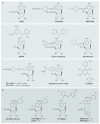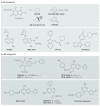Adenosine receptors as therapeutic targets
- PMID: 16518376
- PMCID: PMC3463109
- DOI: 10.1038/nrd1983
Adenosine receptors as therapeutic targets
Abstract
Adenosine receptors are major targets of caffeine, the most commonly consumed drug in the world. There is growing evidence that they could also be promising therapeutic targets in a wide range of conditions, including cerebral and cardiac ischaemic diseases, sleep disorders, immune and inflammatory disorders and cancer. After more than three decades of medicinal chemistry research, a considerable number of selective agonists and antagonists of adenosine receptors have been discovered, and some have been clinically evaluated, although none has yet received regulatory approval. However, recent advances in the understanding of the roles of the various adenosine receptor subtypes, and in the development of selective and potent ligands, as discussed in this review, have brought the goal of therapeutic application of adenosine receptor modulators considerably closer.
Figures







References
-
-
Fredholm BB, IJzerman AP, Jacobson KA, Klotz KN, Linden J. International Union of Pharmacology. XXV. Nomenclature and classification of adenosine receptors. Pharmacol. Rev. 2001;53:527–552. A publication on AR nomenclature, structure, function and regulation by members of NC-IUPHAR subcommittee.
-
-
-
Linden J. Adenosine in tissue protection and tissue regeneration. Mol. Pharmacol. 2005;67:1385–1387. Summarizes four modes of adenosine’s tissue protective action.
-
-
- McGaraughty S, Cowart M, Jarvis MF, Berman RF. Anticonvulsant and antinociceptive actions of novel adenosine kinase inhibitors. Curr. Top. Med. Chem. 2005;5:43–58. - PubMed
-
- Zimmermann H. Extracellular metabolism of ATP and other nucleotides. Naunyn Schmiedebergs Arch. Pharmacol. 2000;362:299–309. - PubMed
-
- Pascual O, et al. Astrocytic purinergic signalling coordinates synaptic networks. Science. 2005;310:113–116. - PubMed
Publication types
MeSH terms
Substances
Grants and funding
LinkOut - more resources
Full Text Sources
Other Literature Sources
Medical
Molecular Biology Databases

